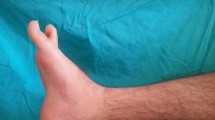Abstract
X-ray is important in the assessment of clubfoot. Stress radiographs give more information than routine radiographs. Because of the inaccuracy of the positioning and the disadvantages of radiation, paediatric orthopaedic surgeons do not like and do not use X-ray examination. In this study we report a technique we use to obtain stress radiographs in paediatric patients with clubfoot using a custom-made radiolucent modular splint. This technique provides better assessment of the initial status and the result of treatment. Although this method has limitations it can help to compare different feet and treatment results with regard to axis and angle. We validated this splint by means of a prospective study in 11 patients with 21 feet having type 2 clubfoot who underwent (PMSTR) in our centre. Two sets of radiographs were taken, one with manual positioning and one with our splint. We found significant differences in the values of midfoot and forefoot radiological parameters between the two sets. We found that the correlation between the clinical and radiological assessment of residual deformity improved significantly for these values when a splint was used to obtain stress views. Hence we recommend routine use of a radiolucent splint for taking stress views to assess residual deformity in clubfoot.
Résumé
Les radiographies sont un élément important dans l’analyses des pieds bots, les radiographies dynamiques donnant plus d’informations que les radiographies standards. Cependant, les chirurgiens orthopédistes n’aiment pas utiliser les radiographies dynamiques, celles-ci entraînent une exposition plus importante aux rayons. Au cours de cette étude, nous rapportons une technique permettant d’obtenir ces clichés dynamiques en utilisant une attelle modulaire, transparente aux rayons X. Cette technique permet de faire une meilleure analyse des stades initiaux de la maladie et des résultats du traitement. Cependant,cette technique a également ses limites. Néanmoins, elle permet de comparer les résultats des différents pieds et des différents traitements en terme d’analyse des axes et d’analyse angulaire. Nous avons validé l’utilisation de cette attelle lors d’une étude prospective chez 11 patients présentant 21 pieds bots de type 2 qui ont bénéficié d’une PMSTR en notre centre. Des radios dynamiques ont été pratiquées, soit en utilisant l’attelle, soit en radio dynamique manuelle. Nous avons trouvé une différence significative dans les valeurs du médio-pied et de l’arrière-pied, lorsque les clichés dynamiques ont utilisé l’attelle en comparaison avec les examens dynamiques manuels. Nous avons également trouvé une meilleure corrélation entre les résultats cliniques et radiologiques de la déformation résiduelle lorsque l’on utilisait l’attelle. Aussi, recommandons-nous d’utiliser cette attelle radio-transparente, en routine habituelle, pour les clichés dynamiques a fin d’analyser les déformations résiduelles dans le pied bot.


Similar content being viewed by others
References
Beatson TR, Pearson JR (1966) A method of assessing correction in clubfeet. J Bone Joint Surg [Br] 48(1):40–50
Catterall A (1991) A method of assessment of the clubfoot deformity. Clin Orthop 264:48–53
Clark JMP (1968) Treatment of clubfoot. Proc R Soc Med 61:33–35
Denis X, Paquot JP (1975) Examen radiologique et surveillance du pied bot congenital. Ann Radiol 18:339–340
Fahrenbach G, Kuehn D, Tachdjian MO (1986) Occult subluxation of subtalar joint in clubfoot (using computerized tomography). J Pediatr Orthop 6:334–339
Kanatli U, Yetkin H, Cila E (2001) Footprint and radiographic analysis of the foot. J Pediatr Orthop 21:225–228
Lehman WB (1980) The clubfoot, 2nd edn. New York: J.B. Lippincott Company
Lenoir JL (1966) Congenital idiopathic talipes. Springfield, Thomas
Ashby ME (1973) Roentgenographic assessment of soft tissue medial release operations in clubfoot deformity. Clin Orthop 90:146–149
Moses N, Allen BL, Pugh LI, Stasikelis PJ (2000) Predictive value of intraoperative clubfoot radiographs on revision rates. J Pediatr Orthop 20:529–532
Oseetreich AE (1990) How to measure angle from foot radiograph? A primer. New York: Springer
Simons GW (1978) Analytical radiography and progressive approach in talipes equinovarus. Orthop Clin North Am 9(1):187–207
Simons GW (1977) Analytical radiography of clubfeet. J Bone Joint Surg [Br] 59(4):485–489
Simons GW (1978) A standard method for the radiographic evaluation of clubfeet. Clin Orthop 135:107–118
Tachdjian MO (2000) Congenital talipes equino varus. In: Tachdjian pediatric orthopaedics, 2nd edn. New York: W.B.Saunders 2428–2556
Templeton AW, MCalister WH, Zim ID (1965) Standardisation of terminology and evaluation of osseous relationships in congenitally abnormal foot. Am J Roentgenol 93:374–381
Vanderwilde R, Staheli L, Chew DE, Malagon V (1988) Measurements on radiographs of the foot in normal infants and children. J Bone Joint Surg [Am] 70(3):407–415
Van Mulken JMJ, Bulstra SK, Hoefnagels NHM (2001) Evaluation of the treatment of clubfoot with the Dimeglio score. J Pediatr Orthop 21:642–647
Wynne-Davies R (1964) Talipes eqinovarus. A review of eighty four cases after completion of treatment. J Bone Joint Surg [Br] 46:464–476
Tarraf YN, Carol NC (1992) Analysis of the components of residual deformity in clubfeet presenting for reoperation. J Pediatr Orthop 12(2):207–216
Author information
Authors and Affiliations
Corresponding author
Additional information
None of the authors received support in any form from any source.
Rights and permissions
About this article
Cite this article
Sambandam, S.N., Gul, A. Stress radiography in the assessment of residual deformity in clubfoot following postero-medial soft tissue release. International Orthopaedics (SICO 30, 210–214 (2006). https://doi.org/10.1007/s00264-005-0057-8
Received:
Revised:
Accepted:
Published:
Issue Date:
DOI: https://doi.org/10.1007/s00264-005-0057-8




